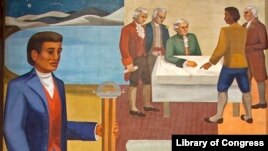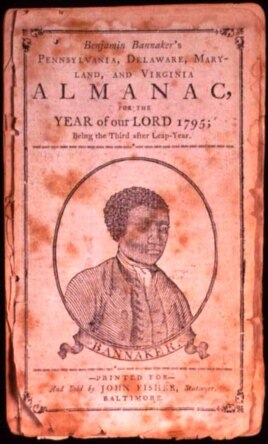14 February, 2016
Benjamin Banneker was born in Baltimore County, Maryland in 1731. His mother was a free black. His father was a freed slave.
At the time, the American colonies were heavily engaged in the slave trade from Africa. Around the time Banneker was born, about 37,000 enslaved people arrived in the colonies. Free black people such as Banneker were rare. Free blacks also faced the risk of being kidnapped and sold as slaves.
A talented youth
Young Benjamin Banneker showed remarkable skill in mathematics and mechanics. He did not regularly go to school because of his work on the family farm. But he did briefly attend a local Quaker school. Quakers are a religious community who believe in racial equality, an unusual idea at the time.

The mural "Benjamin Banneker: Surveyor-Inventor-Astronomer" is at the Recorder of Deeds building in Washington, D.C. Photograph taken by Carol M. Highsmith.
The mechanics of machines greatly interested young Banneker. He showed his mechanical abilities by building an accurate clock made of wood, at the age of 22. Some say it was the only clock of its kind in the Americas. The device continued to run for many years until it was destroyed by fire.
Banneker also used his mathematical knowledge to calculate the time of a solar eclipse. That knowledge was also useful in calculating longitude and latitude, methods for finding a place's position on the globe.
Planning the nation's capital
As a young man, Banneker developed a working relationship with a surveyor named Andrew Ellicott. Surveying is the measuring and mapping of land. It was an important task in a young country where land records needed to be made. Many influential men, including George Washington, worked as surveyors.
In 1791, Ellicott was given the task of surveying land for the new federal district that would become the capital of the United States. Ellicott hired Banneker to help him. They worked to set accurate boundaries for the District of Columbia. Banneker is credited with positioning the starting point at Jones Point in Alexandria, Virginia.
An almanac

A portrait of Benjamin Banneker that appears on the cover of his Almanac, 1795. Courtesy of the Maryland Historical Society, Baltimore.
Banneker put his abilities to use in other ways, too. He began publishing an almanac in 1792. Almanacs are books containing a wide range of information. They often include times and dates for astronomical events, like sunrise and sunset and for high and low tides. It was the kind of information that farmers or fishermen around the Chesapeake Bay would need and use.
In addition, Banneker's almanac gave times for meetings of the courts, including the Supreme Court, as well as essays and other interesting writings.
The almanac was titled the "Pennsylvania, Delaware, Maryland and Virginia Almanac and Ephemeris." Creating it gave Banneker an idea.
The year before the first copy was published, he sent an early version to Thomas Jefferson, who was then the secretary of state. With the book, Banneker sent a letter.
Letter to Jefferson
Jefferson was known throughout the country as the author of the Declaration of Independence. Banneker knew the document stated that "all men are created equal." It also said that all men are "endowed by their Creator with certain unalienable rights, that among these are Life, Liberty and the pursuit of Happiness."
Banneker considered it unfair that those rights should not be recognized for all people in the country.
He said in his letter that Jefferson proposed to safeguard the rights of the people when he wrote his famous document.
"This, Sir, was a time when you clearly saw into the injustice of a state of slavery, and in which you had just apprehensions of the horrors of its condition."
Jefferson, then the nation's secretary of state, replied to Banneker's letter.

Thomas Jefferson's letter to Benjamin Banneker, August 30, 1791, from the U.S. Library of Congress collection.
He said, "No body wishes more than I do to see such proofs as you exhibit, that nature has given to our black brethren, talents equal to those of the other colors of men."
The letter and Jefferson's reply to it raise important questions about the condition of slaves and the young nation's dedication to liberty.
But it also questioned the thoughts and opinions of one of the most famous politicians and thinkers in America at the time. These questions are not easy to answer and they can be asked again and again by successive generations.
Banneker published six almanacs in 28 editions. He continued to live on his farm until his death in 1806. By that time, Thomas Jefferson was serving his second term as President of the United States.
The letter to Benjamin Banneker from Thomas Jefferson can be found online at the Library of Congress website.
Mario Ritter wrote this story for VOA Learning English. Kelly J. Kelly and Kathleen Struck were the editors.
_____________________________________________________________
Words in This Story
accurate –adj. able to produce results that are correct
longitude –n. the distance measured by degrees from east to west around the globe
latitude –n. the distance measured in degrees north to south
ephemeris –n. an document that gives times, dates and position for astronomical objects in the sky like the sun, moon and planets
unalienable –adj. impossible to take away or give up
apprehensions –n. fear that something bad or unpleasant is going to happen, worries
brethren –n. a formal way to say brothers or to refer to fellow members of a church